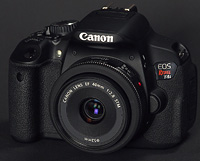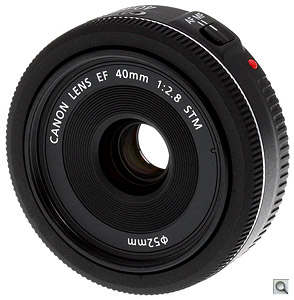Checkin’ out these hot summer pancakes (shooting the Canon 40mm f/2.8 lens)
posted Monday, July 2, 2012 at 10:42 PM EDT
 As the year of the lens rolls on, I snagged the 40mm f/2.8 pancake for the weekend and managed to get off a shot or two with it. Though it didn't dazzle quite as much as the $900 Olympus 75mm M.Zuiko I posted last week, the Canon 40mm pancake could be a good choice for your first prime lens. It's small, light and affordable at $200, and serves both APS-C and full-frame cameras. The new lens is also an STM design, which means it'll focus smoothly with the Canon T4i's new on-sensor phase-detect autofocus system. STM lenses are designed to allow the Canon Rebel T4i to be a little more useful as a camcorder, without a lot of disruptive autofocus noise.
As the year of the lens rolls on, I snagged the 40mm f/2.8 pancake for the weekend and managed to get off a shot or two with it. Though it didn't dazzle quite as much as the $900 Olympus 75mm M.Zuiko I posted last week, the Canon 40mm pancake could be a good choice for your first prime lens. It's small, light and affordable at $200, and serves both APS-C and full-frame cameras. The new lens is also an STM design, which means it'll focus smoothly with the Canon T4i's new on-sensor phase-detect autofocus system. STM lenses are designed to allow the Canon Rebel T4i to be a little more useful as a camcorder, without a lot of disruptive autofocus noise.
Unique to the EF line, the 40mm f/2.8 STM lens and the 18-135mm STM kit lens are focus-by-wire designs, which means turning the focusing ring with the camera off does nothing at all. The lens also doesn't auto-retract when you power off the camera, so sometimes it's a little thicker than a pancake. Focus speed is also a little slower than a USM lens; it also seems slower than the standard 18-55mm II kit lens, but we haven't tested that in the lab. In Live View mode, the autofocus system is slower than even my Olympus E-PL1 with any of its lenses. It is faster than the T3i in Live View mode, both with the 40mm lens and with the 18-55mm kit lens. I have to say, though, I expected a little more speed.
On a full-frame SLR, the Canon EF 40mm lens serves as a near-ideal "normal" lens, which means it'll see the world about the same way you do. On a crop-sensor SLR, though, it's more like a 64mm lens, which is a slight telephoto. For a long time, we've advocated the Canon EF 50mm f/1.8 as a great first prime lens (a prime lens is one that doesn't zoom), but with the crop factor the 50mm lens is equivalent to an 80mm lens; great for portraits, but a little confining for general-purpose photography.

As on other Canon lens designs, a switch on the side of the lens activates Manual focus, but that's where we leave behind the similarity to other Canon lenses. Turning the ring works quite a bit better than it has on many other focus-by-wire systems, and reaching focus is surprisingly easy through the viewfinder. Turning the ring slowly adjusts focus very slowly, while other systems often won't adjust focus at all with only a slight turn. Increasing the turn speed just a little seems to jump to a faster adjustment speed, much like moving an accelerated mouse makes a more dramatic movement. You can even half-press the shutter to have the phase-detect system confirm focus. Manual focus in Live View is a little harder to confirm than via the optical viewfinder, surprisingly.
I first took the 40mm pancake to the local spray ground so the family could cool off in the hot summer weather. My youngest set right to work at the appointed task. (f/3.2, 1/3,200 second, ISO 100)
The bright gray background fooled the camera's meter a bit, underexposing the shadows slightly, but at least that gave me something to work with later on the computer. I used the shadows tool in Photoshop to bring up skin tones in these shots, applying it only sparingly to avoid an artificial appearance. (f/3.2 1/3,200, ISO 100)
A cautionary note about spraygrounds: the camera's autofocus system will focus first on the closest object, which is all too often the water itself. Of course, you can also use this tendency to your advantage. After all, sometimes it's the temporal art your subject's creating that's the story. There are multiple jets of water at play here, so the AF system didn't quite nail the main bit of water in this shot, but it did well enough to capture just one of the moments my son was enjoying. I applied only a minor Levels adjustment. (f/2.8, 1/2,500, ISO 100)
After noticing the harsh shadows, I moved to the other side of the sprayground for better light, which paid off. This shows a good example of lens bokeh at f/2.8. (f/2.8, 1/2,500, ISO 100)
Later I brought my son in for a quick portrait shoot, which he agreed to do if I let him play with the camera afterward. Like father, like son. "Deal," I said. You can see that the lens did very well in this shot, with crisp focus on his eyes. This was at f/7.1. (Those opening the full-res file will notice the leftover milk on his mouth. Apologies for that, the boy drinks a lot of milk.) (f/7.1, 1/125, ISO 100)
This shot is pretty sharp, one of the few I got that was sharp. I was also wrestling with the reflector, held by his little brother, so the tree in this shot is pretty crooked. (Next investment: reflector stand.) (f/5.0, 1/200, ISO 100)
I was a little disappointed with the lens in this shot. Whereas I'm used to Canon USM lenses focusing quickly and accurately almost every time, I had too many missed shots, with only one of eight f/2.8 shots coming out sharp enough to include here, and it's still a little soft. I include it here to show the full bokeh available. Of course, it's not a big surprise that a lens would be soft at its widest setting, but our SLRgear test results show that it's capable of pretty good sharpness, even wide open. (f/2.8, 1/500, ISO 100)
Videos. I also shot two videos to show how well the T4i and 40mm combination worked together, and was underwhelmed. The camera seems to take a very long time to decide the image area is out of focus and is too slow to react, noticeably slower than past Canon camcorders I've owned.
Overall, I think the Canon EF 40mm f/2.8 is a good lens for general photographic purposes. It can be very sharp, and its bokeh is pretty nice (though I'm open to comments from the Bokeh Elite). Most of these images, by the way, were made in the Canon T4i's regular phase-detection mode. I found Live View mode far too slow for the sprayground shots, and perhaps too slow for daily use, but optical viewfinder mode was pretty quick. Video mode is slower than I'd like. Watch for our full T4i review to see how that pans out. Not having dug into the T4i's full set of features, we may find some settings that'll improve things. If we do, we'll amend this report.
Until then, see our review on SLRgear, where the Canon EF 40mm f/2.8 STM lens looks pretty darn good optically.